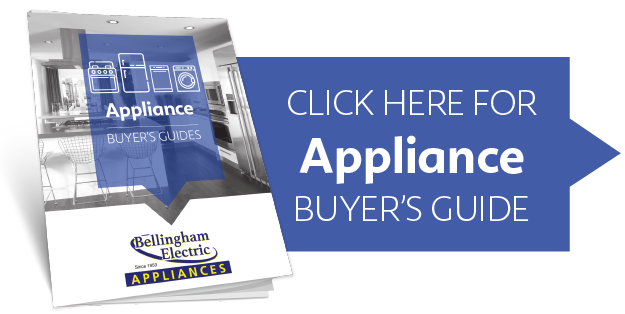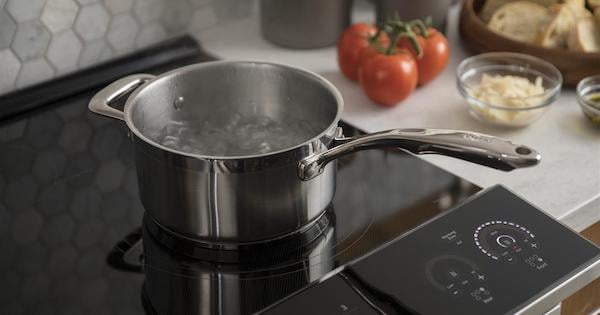
If you're in the market for a new range, you may have heard some discussion about induction cooking. The question is - what is induction cooking and how does it work? It's a cutting-edge cooking method that will make you scratch your head when you see it in action for the first time. An induction range is a type of electric range, but the stovetop cooking surface doesn't get hot, and overall you can expect faster and more precise heating.
In order to understand induction, we will explain how a typical electric range stovetop usually works, then go over the pros and cons of this type of range to help you decide if induction cooking is right for you. (To learn more about ranges, check out our range buying guide!)
An Introduction: How Do Electric Cooktops Typically Work?
Let's start with the familiar electric smooth top range for a reference point. Some refer to this style of cooktop as "radiant heating." As a concept, it's simple: turn the desired knob to a heat setting and the heating element starts to glow red. This heat transitions to the glass and then to the pan.
Glass top radiant burners have a visible sensor rod crossing the center of the heating element that signals the selected control to turn off and on as needed to maintain the heat setting you selected. The sensor and thermostat control will only allow the element to operate at 100% or 0% power, so the burner will continuously turn on and off. This can be challenging when you're trying to simmer or melt without over-cooking anything. During and after use, the glass will remain extremely hot to the touch. It works the same way as thermostatically controlled electric ovens.
So that's "radiant heating" stovetop cooking. But what is induction cooking and how is it different?
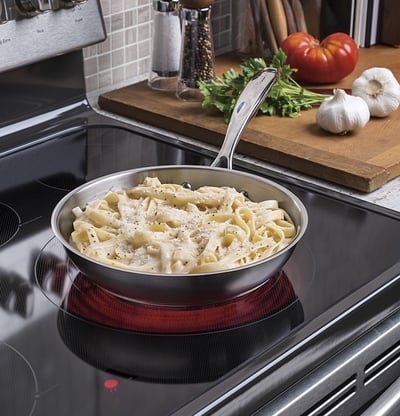
How Induction Cooking Differs from Radiant Heating
At a glance, most people wouldn't notice the difference between an induction range or cooktop compared to a smoothtop electric option since they look so similar. Induction tops will also have a smooth, glossy surface with markings for the placement of cooking pans in different burner zones.
However, if you turn on an induction cooktop element without placing a pan on top of it, you will not notice a red glow or feel heat coming off of the cooking surface. An induction cooktop will only operate when the pan is in place. This is because induction cooking utilizes magnetic power to create heat, directly heating the pot or pan rather than heating an element that then transfers heat through the glass top to the pan.
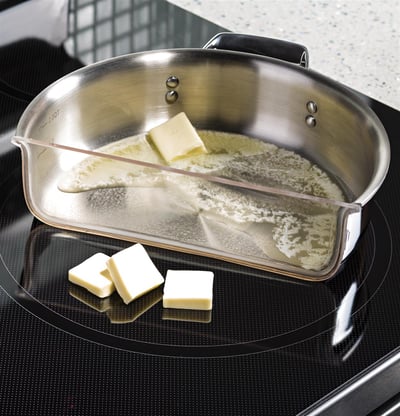
The coil element in this case is a magnet that produces an invisible fluctuating magnetic field that will interact with magnetic metals, such as the iron in a cast iron pan. The magnetic field interacts directly with your pan to create heat, so your pan itself is the heating element! The only heat on the cooking surface comes from the hot pan. And unlike radiant burners that constantly switch on and off, induction maintains a steady flow of magnetic energy, as if you had dialed a flame between high and low on a gas range.
Many models now also come with lights or "virtual flames" that indicate when a burner is in use, such as Samsung's Virtual Flame Technology pictured below.
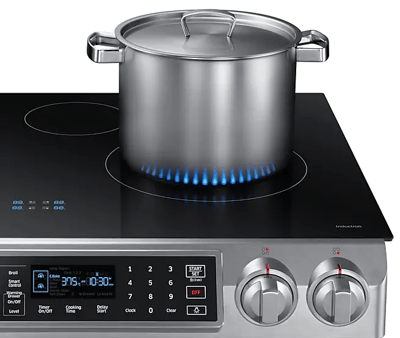
Induction Cooking Pros & Cons
It all sounds great - and it is - but like any new technology, there are pros and cons. Here are the major advantages and disadvantages of induction cooking from our perspective.
Pros:
-
25-50% faster cooking
-
Easier spill clean-up - The glass doesn't get as hot, so food is less likely to adhere to it
-
Instant response when controlling heat settings/selections, like a gas burner
-
Will not operate without cookware - The controls recognize whether cookware is in place or not
-
Ability to auto shut-off if cookware runs dry
-
Safer operation
- Easy to use - Doesn't require a huge change to your stovetop cooking habits!
Cons:
-
Minor low-frequency humming noise when in use that is more noticeable at higher power levels
-
Slight chance that radio frequencies from the range may interfere with some pacemakers
-
Will not work with glass, copper or aluminum pots and pans - requires cookware made with iron and/or steel (if it's magnetic, it will work)
- Usually costs more than a traditional electric range (although costs are coming down)
Should You Buy an Induction Range?
If you value precision when you're cooking on the stovetop, the accurate and consistent heating of an induction stovetop may appeal to you. This type of heating is more efficient and safer than electric or gas cooking as well. You'll need magnetic cookware - Just check if a magnet sticks strongly to the bottom of your pots and pans, or look for cookware marked "induction-compatible." There are plenty of slide-in and freestanding ranges available with this technology, as well as cooktops, from brands like GE Appliances, Frigidaire, KitchenAid, Samsung, and Electrolux.
When it comes to induction ranges, these models are usually higher-end with great features like convection ovens and professional styling. You can find induction ranges for as low as $1,099 (thanks, Frigidaire!) or spend close to $4,000 depending on the styles and features you're looking for. Frigidaire is a leader in offering inexpensive induction ranges in the $1,000 range - check out our Frigidaire induction range reviews for more info!
We hope this article was informative. Feel free to comment or reach out with a question below. We'd love to hear from you!
Editor's Note: This blog was originally written in November of 2017 and has been completely revamped and updated for accuracy as of the publication date noted above.




